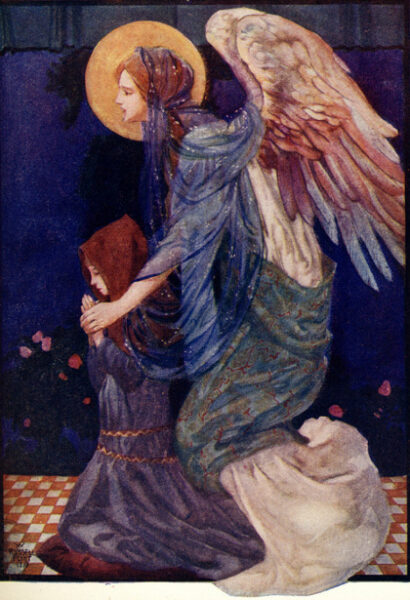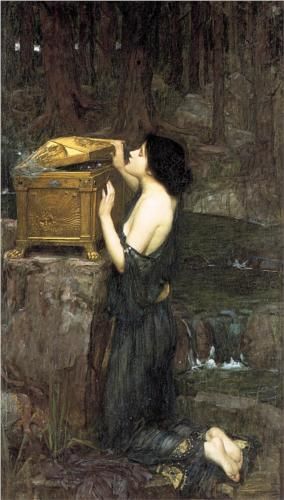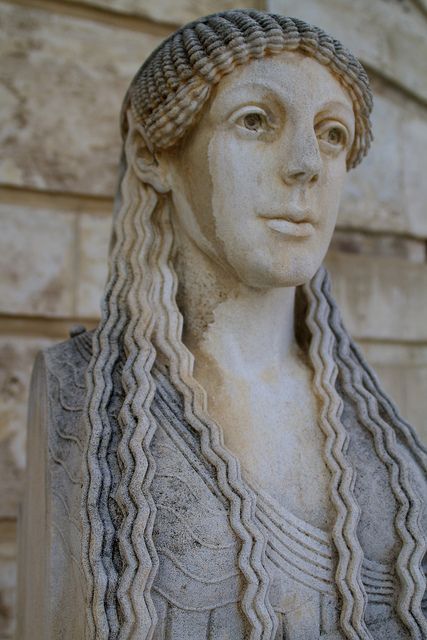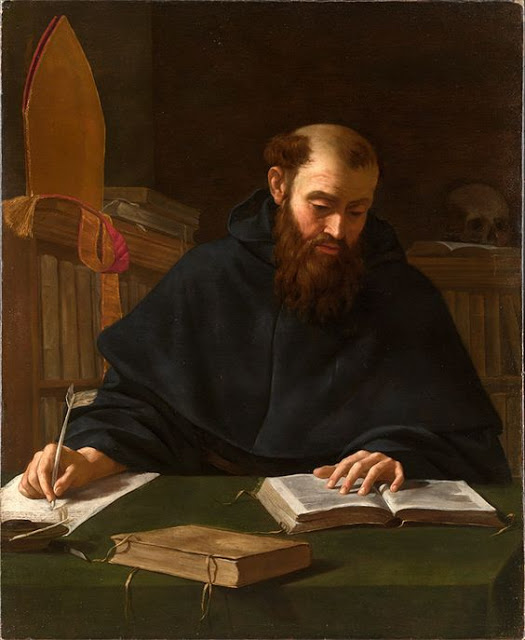Good Demons Vs Bad Demons in Ancient Greece

Demons Feasting
What is a demon, or, in Greek, a ‘daimon’?
You are probably thinking; a malevolent being, something rather devilish, something negative.
Am I right?
Sorry folks but you’re wrong!
You can be forgiven for thinking this, as, today, that is exactly how we see demons but it was not always so.
Demons in Ancient Greece:
Good or bad?
In ancient Greece the word ‘daimon’, derived from the Greek verb “Daiesthai”, meaning to divide, or to distribute, had decidedly positive overtones.
Demons, in ancient Greece, were considered divine, possessors of supernatural powers, fates, guardian spirits, or angels who gave guidance and protection which scarcely figure in Ancient Greek art or mythology, as their presence was felt, rather than seen.

The Guardian Angel – William Russell Flint
There were two types of demons in ancient Greece; Satyrs, or shaggy goats, more mischievous than evil, in the style of the pipe-playing,Greek god Pan, or Shakespeare’s Puck, from “A Midsummer night’s dream”
Then there were the other demons; the divine ones, of “The law”, or “The word”, the rules by which one lived their life.
The demon “Nomos” (Divine law), was married to the daimon “Eusebia”( Piety), their daughter was “’Dike”(Justice)
The “Good” demons were referred to as “Eudaimon”, Eudaimonia or, “Agathodaimon”, noble spirits.
The not so good daimons, resembling the jinns, or genies of Arab folklore, were called “Kakodaimon”, such as the “Keres”, daughters of Nyx (Goddess of night) and Erebus (The personification of shadows), who escaped from the box, opened by Pandora

Pandora – John William Waterhouse
Demons and ancient Philosophers
The Greek idea of demon first appeared in ancient Greece, through the works of Plato, (Classical Greek philosopher, mathematician, student of Socrates).
We see, in Plato’s masterpiece, ‘Symposium’, how Diotima, a female philosopher, teaches Socrates, how love (Eros), is a great demon, and that;
“Everything daemonic is between divine and mortal” Diotima goes on to describe daimons as;”Interpreting and transporting human things to the gods and divine things to men; entreaties and sacrifices from below, and ordinances and requitals from above…”
In other words, demons are demi-Gods, with divine power, ruled and protected by the demi-god satyr; Silenus, existing between heaven and earth, playing the role of intermediaries, between humans and gods.

Diotima of Mantinea. Ancient Greece – Mentioned by Plato in his Symposium.
A demon on my shoulder
In Plato’s ‘Apology’, Socrates stated a mortal could have a personal, lifetime demon, which had the power of determining a person’s fate and claimed to have one of his very own.
His demon, he said, was a favour from the Gods, that frequently warned him, in the form of a “voice”, if he was about to make a mistake, or bad judgment, or danger but never told him how to act, just advised Socrates, so to speak.
Homer, in ancient Greece (8th century BC), who is best known for the two epic poems the ‘The Iliad‘ and ‘The Odyssey’, considered Gods and demons to be similar but distinct.

Homer – Ancient Greek Poet
The Algerian writer, Apuleius of Madaurus, who lived during The Roman Empire and studied Platonism in Athens, states in his book “Metamorphoses” (‘The Golden Ass’);
“They are intermediate powers of a divine order. They fashion dreams, inspire soothsayers,”
By the time of the early Roman Empire, cult statues of demons, which were fed and even dressed and paraded at religious festivals, were envisaged by pagans and Christians alike, as being inhabited by spirits of the Gods, lower than the gods (possibly mortal) but as superior to humanity.
One such cult image, created by the ancient Greek sculptor Pheidias, was that of Athena Parthenos, Greek Goddess of civilization, wisdom, and just war.

Athena Varvakeion, small Roman replica of the Athena Parthenos by Phidias.
So far, so good, the demons are still in favour, still worshiped, still considered as guardian angels, having good, blessed souls.
How demons became bad
How did demons, these delightful, mischievous imps, or guardian angels, become supernatural, malevolent, fallen angels of unclean spirit?
Well, religion raised its head, significantly, the three Abrahamic religions; Judaism, Christianity and Islam, specifically; Christianity.

The Abrahamic religions, Judaism, Christianity and Islam.
The Abrahmic religions, called the cult images idols and the worshiping of them, idolatry.
These statues and effigies, were manmade, with no divine power, no spirit, and were no longer considered beautiful.
“Their land also is full of idols; they worship the work of their own hands, that which their own fingers have made.”
Isaiah 2.8, reflected in Isaiah 17.8.
The above was stated by Isaiah, the 8th century BCE Jewish prophet, who gave his name, to the Book of Isaiah, Old Testament.
Lost in translation
The term demon, acquired much negativity with the Septuagint Bible, the Greek Old Testament translation of the Hebrew bible.
This could literally have been a case of “Lost in translation”, as was the case when the The New Testament was translated from Greek, the Old Testament from Hebrew and Aramaic, and the Apocrypha from Greek and Latin in 1611 and became The King James Bible.

The King James Bible
The Greek word demon was translated as the Greek word “Diabolos”, devil, in English.
Saint Paul or, Saul of Tarsus, as he is also known and who converted from Judaism to Christianity, after experiencing an epiphany, on the road to Damascus, considered the demons of Greek and Roman history, to be malevolent beings and the first thing converted Gentiles needed to do, was stop worshiping these evil creatures.
The late Romans, by this time, believed demons could take on human form, starting plagues and riots.
Saint Augustine of Hippo on demons

Saint Augustine
Caravaggio 1600
In contrast, Saint Augustine, Augustine of Hippo, theologian and philosopher, the most important church father in Western Christianity, considered demons to be purely psychological, with the ability to possess a man, and cause illusions.
As was often the case, church fathers, had a mania for studying non-Christian ancient authors, poo pooing their works, declaring them to be heresy.
Saint Augustine was no different, after writing his book ‘Confessions’, in which he describes his life, before he “Saw the light”, as one of debauchery and begs for atonement, Augustine goes on to ridicule the works of his fellow African author, Apuleius of Madauros.
Saint Augustine, in another of his books, ‘The City of God’, ridicules Apuleius’s book “Metamorphoses”, (The only Latin novel that has survived in its entirety, an imaginative, irreverent, and amusing work that relates the ludicrous adventures of one Lucius, who experiments with magic and is accidentally turned into an ass), calling it
“The Golden Ass”
Augustine, specifically ridicules Apuleius’s belief, that demons are;
“Intermediate powers of a divine order”
Augustine states, that the only Intermediate power, is Jesus Christ.
The modern day take on demons
Today, demons take the leading role, in cults and the occult, where they are recognized as evil, with the power to possess living creatures.
Mischievous Pan, jolly satyr of ancient Greece, has been replaced by Baphomet, a pagan deity, a product of Christian folklore revived in the 19th century as a figure of occultism & Satanism.

Baphomet
Baphomet, first appeared in 11th & 12th century, as a corruption of “Mahomet” or “Muhammad” & later appeared as a pagan idol in trial transcripts of the Inquisition of 14th century Knights Templar
It since been associated with a “Sabbatic Goat”, or Satan; representing duality of male & female, Heaven & Hell, night & day, as above so below signified by raised right arm & downward left.
Where demons are concerned, Guardian Angels have been replaced by Fallen Angelsand that thing on your shoulder, call it an angel, call it your conscience, well, watch out, it might just possess you, in the worst way possible.
Do not fear though, the Greeks always have a solution for everything; in acient Greece, if you were possessed by demons and evil spirits, they were driven out by drilling a hole in your head!
Related links:
The 10 Most Wicked Witches of Ancient Greece
The First Werewolf – Stories from Ancient Greece
The Fates and the Furies – The Moirai and the Erinyes – Fate Vs Destiny in Ancient Greece



